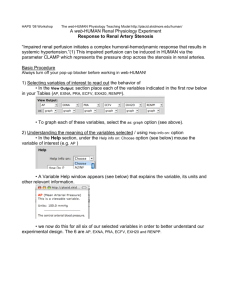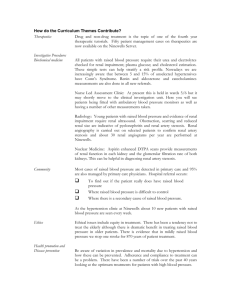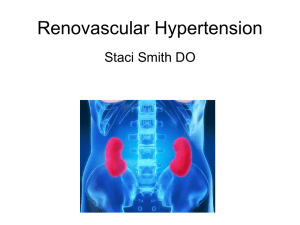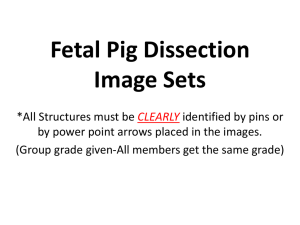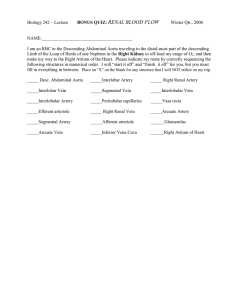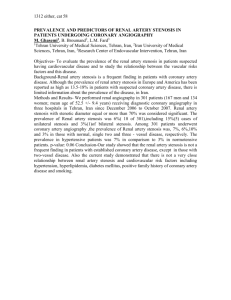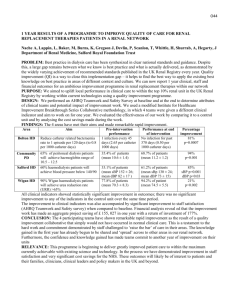Significant reduction in systolic blood pressure following
advertisement
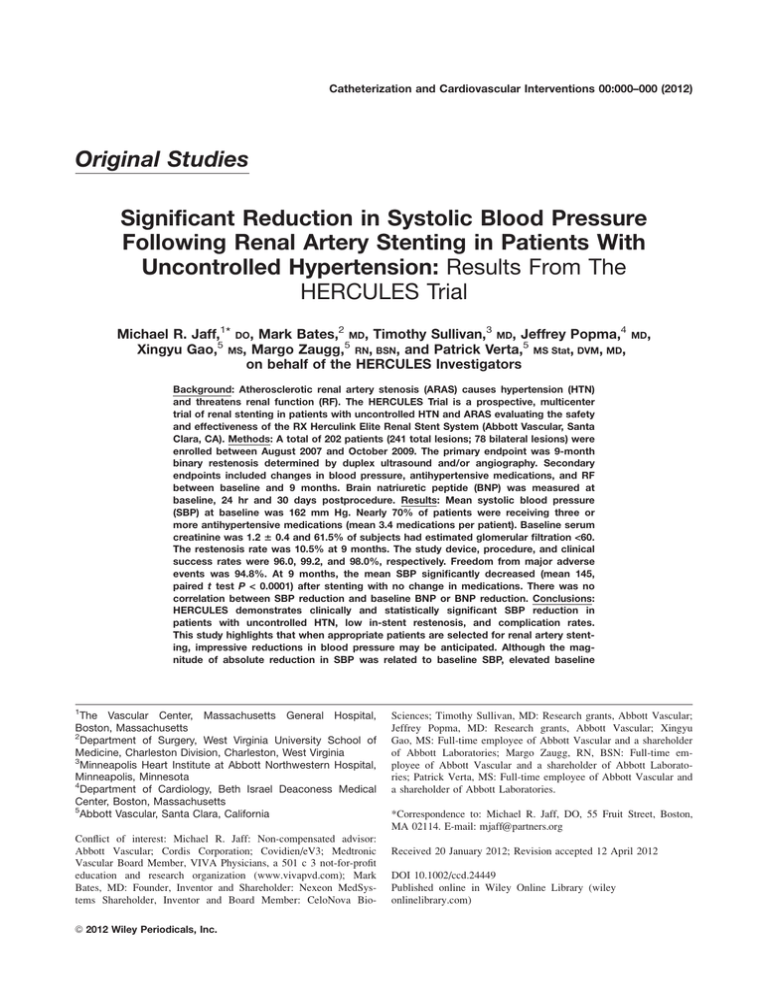
Catheterization and Cardiovascular Interventions 00:000–000 (2012) Original Studies Significant Reduction in Systolic Blood Pressure Following Renal Artery Stenting in Patients With Uncontrolled Hypertension: Results From The HERCULES Trial Michael R. Jaff,1* DO, Mark Bates,2 MD, Timothy Sullivan,3 MD, Jeffrey Popma,4 Xingyu Gao,5 MS, Margo Zaugg,5 RN, BSN, and Patrick Verta,5 MS Stat, DVM, MD, on behalf of the HERCULES Investigators MD, Background: Atherosclerotic renal artery stenosis (ARAS) causes hypertension (HTN) and threatens renal function (RF). The HERCULES Trial is a prospective, multicenter trial of renal stenting in patients with uncontrolled HTN and ARAS evaluating the safety and effectiveness of the RX Herculink Elite Renal Stent System (Abbott Vascular, Santa Clara, CA). Methods: A total of 202 patients (241 total lesions; 78 bilateral lesions) were enrolled between August 2007 and October 2009. The primary endpoint was 9-month binary restenosis determined by duplex ultrasound and/or angiography. Secondary endpoints included changes in blood pressure, antihypertensive medications, and RF between baseline and 9 months. Brain natriuretic peptide (BNP) was measured at baseline, 24 hr and 30 days postprocedure. Results: Mean systolic blood pressure (SBP) at baseline was 162 mm Hg. Nearly 70% of patients were receiving three or more antihypertensive medications (mean 3.4 medications per patient). Baseline serum creatinine was 1.2 6 0.4 and 61.5% of subjects had estimated glomerular filtration <60. The restenosis rate was 10.5% at 9 months. The study device, procedure, and clinical success rates were 96.0, 99.2, and 98.0%, respectively. Freedom from major adverse events was 94.8%. At 9 months, the mean SBP significantly decreased (mean 145, paired t test P < 0.0001) after stenting with no change in medications. There was no correlation between SBP reduction and baseline BNP or BNP reduction. Conclusions: HERCULES demonstrates clinically and statistically significant SBP reduction in patients with uncontrolled HTN, low in-stent restenosis, and complication rates. This study highlights that when appropriate patients are selected for renal artery stenting, impressive reductions in blood pressure may be anticipated. Although the magnitude of absolute reduction in SBP was related to baseline SBP, elevated baseline 1 The Vascular Center, Massachusetts General Hospital, Boston, Massachusetts 2 Department of Surgery, West Virginia University School of Medicine, Charleston Division, Charleston, West Virginia 3 Minneapolis Heart Institute at Abbott Northwestern Hospital, Minneapolis, Minnesota 4 Department of Cardiology, Beth Israel Deaconess Medical Center, Boston, Massachusetts 5 Abbott Vascular, Santa Clara, California Conflict of interest: Michael R. Jaff: Non-compensated advisor: Abbott Vascular; Cordis Corporation; Covidien/eV3; Medtronic Vascular Board Member, VIVA Physicians, a 501 c 3 not-for-profit education and research organization (www.vivapvd.com); Mark Bates, MD: Founder, Inventor and Shareholder: Nexeon MedSystems Shareholder, Inventor and Board Member: CeloNova BioC 2012 Wiley Periodicals, Inc. V Sciences; Timothy Sullivan, MD: Research grants, Abbott Vascular; Jeffrey Popma, MD: Research grants, Abbott Vascular; Xingyu Gao, MS: Full-time employee of Abbott Vascular and a shareholder of Abbott Laboratories; Margo Zaugg, RN, BSN: Full-time employee of Abbott Vascular and a shareholder of Abbott Laboratories; Patrick Verta, MS: Full-time employee of Abbott Vascular and a shareholder of Abbott Laboratories. *Correspondence to: Michael R. Jaff, DO, 55 Fruit Street, Boston, MA 02114. E-mail: mjaff@partners.org Received 20 January 2012; Revision accepted 12 April 2012 DOI 10.1002/ccd.24449 Published online in Wiley Online Library (wiley onlinelibrary.com) 2 Jaff et al. BNP levels were not predictive of reduction in SBP. Further studies for predictors of clinical response following percutaneous renal revascularization are needed. C 2012 Wiley Periodicals, Inc. V Key words: renal artery stenosis; renovascular hypertension; stents INTRODUCTION Renal artery stent revascularization (RASR) has been popularized as a safe procedure for patients with atherosclerotic renal artery stenosis (ARAS). However, the clinical efficacy of this procedure as a method of lowering blood pressure and preventing deterioration in ischemic nephropathy resulting in end-stage kidney disease remains unproven. Despite evidence linking ARAS to hypertension (HTN) and chronic kidney disease [1] and data supporting RASR in patients with ARAS [2], the evidence of renin-mediated HTN being ameliorated by RASR is found predominantly in multicenter prospective commercial sponsored registries [3] or in randomized trials using percutaneous transluminal angioplasty (PTA) as the revascularization strategy, one felt by most experts to result in inferior technical and clinical outcomes [4]. More recently, two largescale randomized trials have suggested that RASR offers no benefit in preservation of renal function (RF) when compared with optimal antihypertensive therapy [5,6]. However, these trials have serious methodologic flaws that pose difficulties when attempting to extrapolate their data to the patient with ARAS. In addition, the outcomes of previous renal artery stent registries showed modest reductions in blood pressure suggesting that the pretreatment blood pressure elevations may have been unrelated to renal artery stenosis. Because of the variability in results, investigators have attempted to provide predictors of clinical success before performance of an invasive arterial procedure. These predictors have fallen into three basic categories: clinical [7,8] and imaging based (renal resistive indices [9], or nuclear isotopic imaging [10]); preprocedure laboratory assessment with brain natriuretic peptide (BNP) [11,12]; and periprocedural indicators (translesional pressure gradients [13,14], fractional flow reserve [15], and intravascular ultrasound [16]). In an effort to expand the experience with renal artery stenting for patients with HTN refractory to standard medical therapy and further analyze the predictive value of BNP, we performed a prospective multicenter study of patients with ARAS and uncontrolled HTN. METHODS Study Design and Patients The HERCULES trial is a prospective multicenter single-arm clinical study of patients with significant renal artery stenosis and uncontrolled HTN treated with the RX Herculink Elite Renal Stent System (Abbott Vascular, Santa Clara, CA). Two hundred two patients were enrolled in the HERCULES trial between August 2007 and October 2009. All patients underwent assays for BNP before and after renal artery stenting. The study was registered at clinicaltrials.gov (NCT00490841) and individual institutional review board approval was obtained at each site. All patients provided signed informed consent before the enrollment and the conduct, performance, monitoring, auditing, data recording, and analysis all strictly adhered to Good Clinical Practice standards [17]. Eligible patients included those with uncontrolled HTN defined as systolic blood pressure (SBP) 140 mm Hg or diastolic blood pressure 90 mm Hg, despite maximal doses of at least two antihypertensive agents in appropriate combinations in association with renal artery stenosis 60% via angiographic visual estimate and suboptimal PTA result defined as one of the following: 50% residual stenosis, persistent translesional pressure gradient, flow limiting dissection, or thrombolysis in myocardial infarction (TIMI) flow <3. Patients who underwent successful primary renal artery stent deployment or successful PTA were not eligible for inclusion in HERCULES. Patients with unilateral or bilateral ARAS were eligible, if the lesion was within 10 mm of the aorto-ostial junction, and the reference vessel diameter was between 4 and 7 mm. Lesions representing in stent restenosis following a prior endovascular stent revascularization were not eligible for enrollment. Patients with serum creatinine>2.5 mg/dL, recent myocardial infarction, stroke or transient cerebral ischemia, impaired left ventricular ejection fraction (25%), ARAS to a solitary functioning kidney, or transplant renal artery stenosis were ineligible for participation. Procedure All enrolled subjects received anticoagulation per hospital standard during angioplasty of the renal artery. Selective angiography in at least two views was performed to confirm angiographic eligibility (60%) of the stenosis. PTA was performed with a standard balloon dilatation catheter. Immediately following PTA, the lesion was assessed for continued eligibility, i.e., suboptimal PTA, and treated with the study device. The RX Herculink Elite Renal Stent System features a Catheterization and Cardiovascular Interventions DOI 10.1002/ccd. Published on behalf of The Society for Cardiovascular Angiography and Interventions (SCAI). Significant BP Reduction After Renal Artery Stenting balloon expandable stent composed of L605 Cobalt Chromium. The stent design is based on a series of zig-zagging rings with multiple links per ring. The study stent included 12, 15, and 18 mm lengths with diameters ranging from 4 to 7 mm. All patients received aspirin 325 mg orally once daily, and clopidogrel either 75 mg orally once daily for 4 days before the procedure, or as a single loading dose of 300 mg orally within 24 hr before the procedure. Heparin was used as the procedural anticoagulant agent. PTA was performed in a standard fashion, and the patient was eligible for enrollment if there was a persistent stenosis 50%, a mean 10 mm Hg (or peak systolic 20 mm Hg) translesional pressure gradient using a 4-Fr catheter, or if there were flow limiting dissections or TIMI flow <3 (with TIMI 3 defined as clearance of angiographic contrast within two cardiac cycles). Only patients with suboptimal results following PTA were eligible for inclusion in HERCULES. Following stent placement, aspirin 325 mg orally once daily was continued for a minimum of 12 months and clopidogrel 75 mg orally once daily for at least 4 weeks. Clinical Follow-Up and Assessments Blood pressure and RF measurements were performed following the procedure and at 1, 6, 9, 12, 24, and 36 months using accepted and reproducible techniques for blood pressure assessment. Additionally, all enrolled patients underwent BNP assays before and within 24 hr and 30 days following the procedure. All patients also underwent renal artery duplex ultrasonography within 30 days following the procedure and at 9, 24, and 36 months. An independent vascular ultrasound core laboratory interpreted all images with experience in multicenter vascular device trials (VasCore, Massachusetts General Hospital, Boston, MA). The core laboratory used prespecified criteria to determine degree of stenosis [18]. For the primary endpoint analysis, the core laboratory evaluation was used to determine the binary restenosis rate. A renal arteriogram was required at 9 months, if the duplex ultrasound was determined to be inadequate by the ultrasound core laboratory or at any point in time at the discretion of the investigator. All procedural and follow-up angiograms were assessed by an independent Angiographic Core Laboratory (Beth Israel Deaconess Medical Center, Boston, MA) by using quantitative angiographic methods. Statistical Analysis The primary endpoint was tested under the hypothesis of superiority of the 9-month binary restenosis rate 3 after renal artery stenting with the Herculink Elite stent to a performance goal (PG). Based on the published literature of renal artery stenting for ARAS, at the time, the HERCULES study was developed, a PG of 28.6% was estimated. The null hypothesis was that the 9month restenosis rate was greater or equal to the PG; the alternative is that it was less than the PG. Under an assumed restenosis rate of 20%, a one-sided significance level of 0.05, a sample size of 161 lesions were required to provide 80% power. To allow for a 20% lost to follow-up rate, 202 patients were enrolled. The primary endpoint was analyzed on an intent-to-treat basis, using available DUS or angiographic data, for all lesions in which the Herculink Elite stent was implanted. For subjects with bilateral renal artery lesion treatment, both treated lesions were included. The primary endpoint was analyzed by calculating the one-sided 95% confidence limit of the observed binary restenosis rate at 9 months for all treated target lesions. Success would be concluded if the upper one-sided 95% confidence limit is less than 28.6%. A P value was computed using a one-sided exact binomial test. Assessment of the impact of potentially correlated bilateral lesions on the primary endpoint outcome was performed using the generalized estimating equations (GEE) method. A composite safety secondary endpoint including all cause mortality, embolization resulting in kidney damage and ipsilateral nephrectomy at 30 days and clinically driven target lesion revascularization up to 270 days postprocedure, was estimated by using Kaplan– Meier methodology. Standard error was calculated using the Greenwood formula and life tables by using the product limit methodology. The 30-day safety endpoint was also summarized by count, percentage, and 95% confidence interval (CI). Other secondary endpoints included: device success, defined on a per device basis as the achievement of successful delivery and deployment of the assigned device(s) and successful removal of the delivery system as intended to the designated location; procedure success, defined on a per lesion basis as the attainment of a final result of <30% residual stenosis as determined by the angiographic core laboratory; clinical success, defined on a per subject basis as procedure success without major adverse events [(MAE) defined as death, nephrectomy, and significant embolic events resulting in kidney damage] or access site event requiring surgical or percutaneous intervention before hospital discharge; changes in blood pressure, antihypertensive medication in-take, and RF (measured by sCr); primary patency, defined as <60% stenosis by duplex ultrasonography (DUS) without prior reintervention, as determined by DUS or angiogram; secondary patency, Catheterization and Cardiovascular Interventions DOI 10.1002/ccd. Published on behalf of The Society for Cardiovascular Angiography and Interventions (SCAI). 4 Jaff et al. defined as <60% stenosis of the target lesion, regardless of PTA, stenting, or bypass since index procedure. This degree of in-stent restenosis has been validated for renal artery duplex ultrasonography. Additional analyses included MAE; clinically indicated TLR and all TLR; and predictive value of baseline serum BNP level and changes in BNP levels on SBP changes. Demographics and other baseline characteristic variables were summarized descriptively. Means, standard deviations, ranges and two-sided 95% CI based on normal distribution were displayed for the continuous variables. For binary variables involving proportions, counts, percentages, and Clopper–Pearson two-sided 95% CI were presented. The Kaplan–Meier method was used to estimate the cumulative incidence rate of clinically indicated target lesion revascularization (TLR) and TLR, death, ipsilateral nephrectomy, and embolic events resulting in kidney damage. All data summaries and statistical analyses were performed using SASV for Windows, version 9.1 or higher (SAS Institute, Cary, NC). R TABLE I. Baseline Demographics and Clinical Characteristics Variables Age (years) Female Gender Caucasian African American Latino-Hispanic Diabetes History of tobacco use Hypercholesterolemia requiring meds Coronary artery disease Baseline systolic blood pressure (mm Hg) Baseline diastolic blood pressure (mm Hg) Serum creatinine (mg/dL) Estimated glomerular filtration rate (eGFR)a Brain natriuretic peptide (pg/mL) Antihypertensive medication intake One medication Two medications Three medications More than three medications TABLE II. Anatomic Characteristicsa Two hundred two patients were enrolled in the HERCULES trial. The mean age of the patient population was 72 years, and 62% of enrolled patients were female. The majority of patients were Caucasian, had a history of hypercholesterolemia and either active or recently discontinued tobacco use. Diabetes mellitus was found in 45% of the cohort, and 67% had concomitant coronary artery disease. Baseline mean standard deviation (SD) systolic and diastolic blood pressures were 162 19/78 12 mm Hg, respectively. Ninetynine percent of patients required two or more antihypertensive agents for blood pressure management, and nearly 70% required three or more medications (Table I). Patients required, on average, 3.4 medications. One-third of treated patients had bilateral ARAS, and the mean baseline percent diameter stenosis was 81.3% as determined by the site (66% as determined by the independent angiographic core laboratory) (Table II). Variables The primary endpoint of restenosis at 9 months following renal artery stenting was 10.5% (22/209), (upper 95% confidence limit 14.7%), below the predetermined PG established for the HERCULES study. The primary objective of the study was met (P < 0.0001). Using GEE models to account for the potential correlation between bilateral lesions yielded similar results: a 9-month binary restenosis rate of 10.5% with a onesided upper 95% confidence limit of 14.5%. DUS was 72.1 62.4% (76/202) 83.7% (169/202) 7.9% (16/202) 7.6% (15/202) 45.0% (91/202) 56.9% (115/202) 82.2% (166/202) 67.3% (136/202) 162.3 18.5 77.7 11.5 1.2 0.4 58.0 20.8 181.2 297.0 0.5% 29.2% 30.7% 39.6% (1/202) (59/202) (62/202) (80/202) a eGFR ¼ 186 (Scr)1.154 (age)0.203 0.742 (if female) 1.210 (if African-American). RESULTS Patients Primary and Secondary Endpoints N ¼ 202 Preprocedure De novo lesions Unilateral lesions Bilateral lesions Site reported diameter stenosis (%) Core laboratory reported diameter stenosis (%) Core laboratory reported minimum lumen diameter (mm) Core laboratory reported reference vessel diameter (mm) Lesion length (mm) Heavy calcification Suboptimal PTA outcome Residual stenosis 50% 10 mm Hg mean gradient or 20 mm Hg peak systolic gradient across the lesion Flow-limiting dissection (NHLBI grade D) or TIMI flow <3 Postprocedure Core laboratory reported diameter stenosis (%) Core laboratory reported minimum lumen diameter (mm) Study device success Procedure success Clinical success a N ¼ 202 subjects/ M ¼ 241 lesions 100% (241/241) 67.6% (163/241) 32.4% (78/241) 81.3 10.0 65.9 11.4 1.8 0.7 5.4 1.1 8.5 3.1 27.8% (67/241) 90.7% (214/236) 25.0% (59/236) 4.7% (11/236) 3.4 12.5 5.1 0.8 96.0% (237/247) 99.2% (238/240) 98.0% (197/201) Per lesion. used to determine restenosis for 190 lesions, and angiography was used for the remaining 19 lesions. At the prespecified follow-up of 9 months, the mean (SD) systolic and diastolic blood pressures Catheterization and Cardiovascular Interventions DOI 10.1002/ccd. Published on behalf of The Society for Cardiovascular Angiography and Interventions (SCAI). Significant BP Reduction After Renal Artery Stenting were 145 21/75 12 mm Hg, respectively. There was a statistically significant reduction in SBP compared to preintervention (paired t test: P < 0.0001) (Figure 1). There was no reduction in the number of antihypertensive medications, and RF, as measured by estimated glomerular filtration (eGFR) rates as calculated by the Cockcroft-Gault formula, was unchanged (Table III). The magnitude of absolute reduction in SBP was related to the severity of base- Fig. 1. Comparison of percentage of patients with specific systolic blood pressures at baseline and 9-months following renal artery stent deployment. TABLE III. Blood Pressure and Medications Variables Baseline 1 month 9 months P SBP (mm Hg) 162 18 145 21 145 21 <0.0001a DBP (mm Hg) 78 12 76 11 75 12 0.05a eGFR 58 21 59 21 57 23 0.38a 2 (mL/min per 1.73 m ) BNP 181 297 154 235 NA 0.01 3 antihypertensive 70 68 66 0.61b meds (%) % ACEI or ARB (%) 76 76 76 0.99b % Diuretics (%) 65 63 60 0.60b a P value compares baseline to 9 months. P value compares baseline, 1 month, and 9 months. 5 line systolic HTN before intervention. For patients who had a reduction in SBP, those with preprocedure SBP >180 mm Hg experienced a mean SBP reduction of 48 mm Hg at 9 months, while those patients whose baseline SBP was between 140 and 160 mm Hg had a 23 mm Hg reduction in SBP at 9 months (Table IV). Over 77.5% of patients showed a reduction in SBP at 9-months. There was no difference in the magnitude of SBP response among patients treated for bilateral RAS compared with those treated for unilateral RAS. Only two lesions were determined not to have demonstrated procedural success, while four patients did not meet the study definition of clinical success (Table V). The 30-day procedural safety was excellent, with only one death and two patients experiencing renal atheromatous embolization resulting in kidney damage. The 30-day composite safety endpoint rate was 1.5%. The overall composite safety endpoint, which also included clinically driven TLR at 9 months, resulted in an event-free rate of 94.8% by Kaplan–Meier methodology (Fig. 2). Although there was a significant reduction in BNP following renal artery stenting, preprocedure BNP levels were not predictive of a significant improvement in postintervention systolic arterial blood pressure. Of the 165 patients with available BNP data at baseline and 1 month and who showed a reduction in SBP at 9 months, 86 had a high baseline BNP (>99 pcg/mL) and 79 had a normal baseline BNP. The scatter plot (Fig. 3) does not show any linear or nonlinear trend between baseline BNP levels and post-treatment SBP response. Testing the ad-hoc hypothesis that the slope of the regression line is zero yields a value of P ¼ 0.33. A similar analysis was conducted on change in BNP levels. This analysis also did not show any predictive trend (Fig. 4). b TABLE IV. Systolic Blood Pressure Change by 1 Category at 9 Months Improved by 1 CategoryDecrease in SBP (mm Hg)9-Month SBP (mm Hg) 180 mm Hg* Mean SBP 194 12 (n ¼ 39) 94% (n ¼ 34) 146 21 160, < 180 mm Hg** Mean SBP 167 6 (n¼49) 71% (n ¼ 30) 136 13 140, < 160 mm Hg*** Mean SBP 150 5 (n ¼ 113) 44% (n ¼ 42) 127 9 *Unknown (n ¼ 3). **Unknown (n ¼ 7). ***Unknown (n ¼ 18). Catheterization and Cardiovascular Interventions DOI 10.1002/ccd. Published on behalf of The Society for Cardiovascular Angiography and Interventions (SCAI). 6 Jaff et al. Fig. 2. Kaplan–Meier survival curve: Freedom from death, ipsilateral nephrectomy, and embolic events resulting in kidney damage through 30 days and clinically indicated target lesion revascularization through 270 days (intent-to-treat population). Fig. 3. Lack of correlation between pretreatment brain natriuretic peptide (BNP) level and change in systolic blood pressure. DISCUSSION Renal artery stenting has been criticized for failing to demonstrate beneficial clinical results when compared to medical therapy [19]. However, a major limitation of prior prospective registries is based on the specific patient cohorts included. The HERCULES trial recruited patients with significant ARAS who had HTN suboptimally controlled on at least two medications. Seventy-five percent of patients were receiving antagonists of the renin-angiotensin-aldosterone system [i.e., angiotensin converting enzyme inhibitor (ACEI) or angiotensin receptor antagonist (ARB)], with another 60% taking diuretics, a combination felt to be very effective for the treatment of renovascular HTN. HERCULES demonstrated that patients with the most severe HTN before renal artery stent deployment benefited from a reduction in blood pressure not experienced with medical therapy, regardless of the number of agents used. Fig. 4. Lack of correlation between change in BNP level and change in systolic blood pressure. The STAR trial [5] demonstrated an alarming number of adverse procedure-related complications, including two deaths in the group randomized to stents, resulting in an overall complication rate of 17%. In contrast, HERCULES demonstrated excellent procedure related safety, with a 30-day composite safety endpoint rate of 1.5%. Patients enrolled in ASTRAL [6] were eligible, if investigators felt that revascularization or medical therapy were potentially equally reasonable. Therefore, patients most likely to benefit from endovascular revascularization (e.g., patients with severe bilateral renal artery stenosis and drug-resistant HTN) were not eligible for participation. Of those patients included, 40% of patients had hemodynamically insignificant ARAS. In addition, the primary endpoint outcome, improvement in RF, was similar in the revascularization and the medically treated arms. One possible explanation for this finding was that a significant number of patients in ASTRAL had normal RF at baseline. There was a significant increase in procedure-related Catheterization and Cardiovascular Interventions DOI 10.1002/ccd. Published on behalf of The Society for Cardiovascular Angiography and Interventions (SCAI). Significant BP Reduction After Renal Artery Stenting complications in ASTRAL as well (23 episodes include two deaths and three limb amputations), a finding not noted in HERCULES. LIMITATIONS The major limitation of the HERCULES trial was the single-arm nature of the trial, however, accepting this, the safety and efficacy were superior to the revascularization arms of ASTRAL and STAR. Patients were eligible for inclusion if blood pressure was suboptimally controlled on two or more antihypertensive medications. Although the standard definition of resistant HTN requires treatment with three or more medications, we felt that in association with hemodynamically significant renal artery stenosis, this inclusion criterion was adequate. Given that the majority of patients were Caucasian, the findings in HERCULES may not be generalizable among other ethnic and racial populations. A disappointing finding of the HERCULES study was the absence of evidence of a predictive value for BNP levels. This was the largest prospective series evaluating the predictive role of BNP in patients with ARAS and HTN. Neither the preprocedure BNP values nor the change in BNP values predicted the clinical benefit of renal artery stent deployment on blood pressure reduction. Clinical, imaging, and laboratory predictors of benefit from renal artery stenting remain elusive, given the lack of benefit of screening BNP. CONCLUSION The HERCULES trial has demonstrated excellent safety with a cobalt chromium balloon expandable stent for ARAS, but more importantly has established impressive reduction in systolic (and to a lesser degree, diastolic) blood pressures in appropriately selected patients with hemodynamically significant renal artery stenosis and uncontrolled HTN despite an average use of 3.4 antihypertensive agents. Although the trial was not designed or powered to define clinical predictors of blood pressure response the nonlinear relationship between baseline SBP and percent SBP improvement suggests that patients with higher baseline SBP may benefit most from the procedure. The quest for a clinical, imaging, or laboratory biomarker of blood pressure response from renal artery stent deployment remains elusive, given the absence of predictive value of BNP. REFERENCES 1. Garovic VD, Textor SC. Renovascular hypertension and ischemic nephropathy. Circulation 2005;112:1362–1374. 7 2. Caps MT, Zierler RE, Polissar NL, Bergelin RO, Beach KW, Cantwell-Gab K, Casadei A, Davidson RC, Strandness DE. Risk of atrophy in kidneys with atherosclerotic renal artery stenosis. Kidney Int 1998;53:735–742. 3. Rocha-Singh K, Jaff MR, Rosenfield K, ASPIRE-2 Trial Investigators. Evaluation of the safety and effectiveness of renal artery stenting after unsuccessful balloon angioplasty: The ASPIRE-2 study. J Am Coll Cardiol 2005;46:776–783. 4. vanJaarsveld BC, Krijnen P, Pieterman H, Derkx FH, Deinum J, Postma CT, Dees A, Woittiez AJJ, Bartelink AKM, In T Veld AJM, Schalekamp MADH. The effect of balloon angioplasty on hypertension in atherosclerotic renal-artery stenosis. dutch renal artery stenosis intervention cooperative study group. N Engl J Med 2000;342:1007–1014. 5. Bax L, Woittiez AJ, Kouwenberg HJ, Mali WP, Buskens E, Beek FJ, Braam B, Huysmans FTM, SchultzeKool LJ, Rutten MJCM, Doorenbos CJ, Aarts JCNM, Rabelink TJ, Plouin PF, Raynaud A, van Montfrans GA, Reekers JA, van den Meiracker AH, Pattynama PMT, van de Ven PJG, Vroegindeweij D, Kroon AA, de Haan MW, Postma CT, Beutler JJ. Stent placement in patients with atherosclerotic renal artery stenosis and impaired renal function: A randomized trial. Ann Intern Med 2009;150:840–848, W150–W151. 6. The ASTRAL Investigators. Revascularization versus medical therapy for renal-artery stenosis. N Engl J Med 2009;361:1953– 1962. 7. Murray S, Martin M, Amoedo M, Garcia C, Jornet A, Vera M, Oliverac A, Gomez X, Craver L, Real M, Garcia L, Botey A, Montanya X, Fernandez E. Rapid decline in renal function reflects reversibility and predicts the outcome after angioplasty in renal artery stenosis. Am J Kidney Dis 2002; 39:60–66. 8. Rocha Singh KJ, Mishkel GJ, Katholi RE, Ligon RA, Armbruster JA, McShane KJ, Zeck KJ. Clinical predictors of improved long-term blood pressure control after successful stenting of hypertensive patients with obstructive renal artery atherosclerosis. Catheter Cardiovasc Interv 1999;47:167–172. 9. Radermacher J, Chavan A, Bleck J, Vitzthum A, Stoess B, Gebel MJ, Galanski M, Koch KM, Haller H. Use of doppler ultrasonography to predict the outcome of therapy for renal-artery stenosis. N Engl J Med 2001;344:410–417. 10. La BatideAlamore A, Azizi M, Froissart M, Raynaud A, Plouin PF. Split renal function outcome after renal angioplasty in patients with unilateral renal artery stenosis. J Am Soc Nephrol 2001;12:1235–1241. 11. Silva JA, Chan AW, White CJ, Collins TJ, Jenkins JS, Reilly JP, Ramee SR. Elevated brain natriuretic peptide predicts blood pressure response after stent revascularization in patients with renal artery stenosis. Circulation 2005;111:328– 333. 12. Staub D, Zeller T, Trenk D, Maushart C, Uthoff H, Breidhardt T, Klima T, Aschwanden M, Socrates T, Arenja N, Twerenbold R, Rastan A, Sixt S, Jacob AL, Jaeger KA, Mueller C. Use of B-type natriuretic peptide to predict blood pressure improvement after percutaneous revascularization for renal artery stenosis. Eur J Vasc Endovasc Surg 2010;40:599– 607. 13. Leesar MA, Varma J, Shapira A, Fahsah I, Raza ST, Elghoul Z, Leonard AC, Meganathan K, Ikram S. Prediction of hypertension improvement after stenting of renal artery stenosis: Comparative accuracy of translesional pressure gradients, intravascular ultrasound, and angiography. J Am Coll Cardiol 2009;53:2363–2371. Catheterization and Cardiovascular Interventions DOI 10.1002/ccd. Published on behalf of The Society for Cardiovascular Angiography and Interventions (SCAI). 8 Jaff et al. 14. De Bruyne B, Manoharan G, H J Pijls N, Verhamme K, Madaric J, Bartunek J, Vanderheyden M, Heyndrickx GR. Assessment of renal artery stenosis severity by pressure gradient measurements. J Am Coll Cardiol 2006;48:1851–1855. 15. Subramanian R, White CJ, Rosenfield K, Bashir R, Almagor Y, Meerkin D, Shalman E. Catheter Cardiovasc Intervent 205;64:480–486. 16. Leesar MA, Varma J, Shapiro A, Fahsah I, Raza ST, Elghoul Z, Leonard AC, Meganathan K, Ikram S. Prediction of hypertension improvement after stenting of renal artery stenosis: Comparative accuracy of translesional pressure gradients, intravascular ultrasound, and angiography. J Am Coll Cardiol 2009; 53:2363–2371. 17. ICH Harmonised Tripartite Guideline E6: Note for Guidance on Good Clinical Practice. (PMP/ICH/135/95). European Medicines Agency, 2002. 18. Galin I, Trost B, Kang J, Lookstein R, Jaff MR, et al. Validation of renal duplex ultrasound in detecting renal artery stenosis post stenting. Presented at the American College of Cardiology Annual Scientific Sessions, March 2008, Chicago, Illinois. 19. Balk E, Raman G, Chung M, Ip S, Tatsioni A, Alonso A, Chew P, Gilbert SJ, Lau J. Effectiveness of management strategies for renal artery stenosis: A systematic review. Ann Intern Med 2006;145:901–912. Catheterization and Cardiovascular Interventions DOI 10.1002/ccd. Published on behalf of The Society for Cardiovascular Angiography and Interventions (SCAI).
